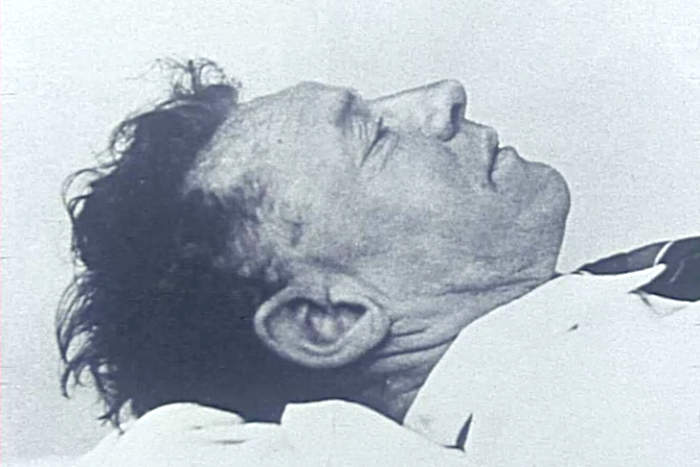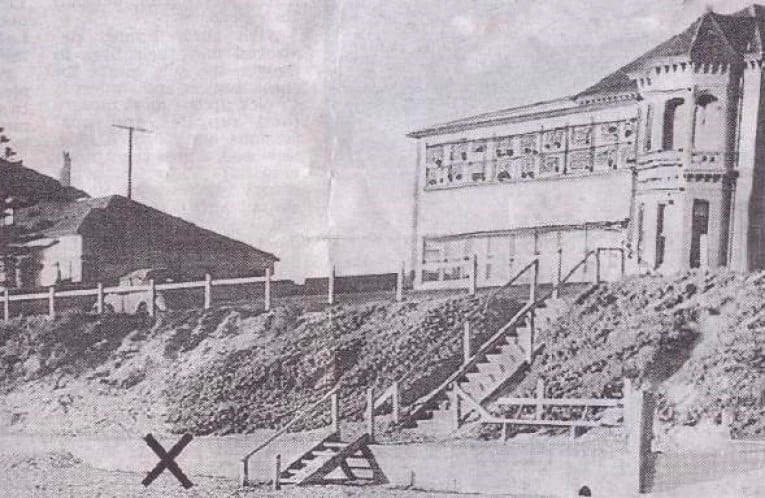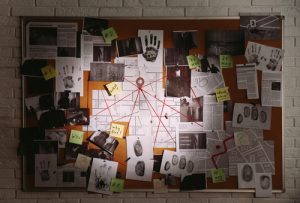A body found an Australian beach may have been a murder victim but his identity, murder weapon, motive and the murderer are still unknown in this case.
Also known as the Somerton Beach mystery or the ‘unknown man’. On 1 December 1948, a man was found on Somerton beach, Adelaide, South Australia. The man was smartly dressed, well-built. He had no belongings on him, no identification and the tags were removed on his clothes. He had been noticed the previous evening, lying in the same position and was drunk, smoking a cigarette. However, on December 1st, he was found dead.

Photo of the dead man found on Somerton Beach, Adelaide, on the morning of 1 December 1948.
The coroner was unable to determine what the cause of this death was or if he was murdered, it was considered most likely he was poisoned. No trace of poison was found but it was said that it could be untraceable. There were other clues such as the pattern of blood pooling in the corpse which suggested that he could have died elsewhere but had been moved to the beach.
The man’s identity was proved to be impossible to find out with all clothing tags being cut off. In a suitcase found at the Adelaide train station was believed to be the man’s but the clothes inside also had no tags. There was an exception of some items saying ‘Kean’ or ‘T Keane’ however, these names could not be tracked down. Details such as the stitching of his jacket and the directions of stripes on his tie meant he had come from America.

The “X” is the location on Somerton beach where the corpse of The Somerton Man was found.
The man had a train ticket from Adelaide to the beach and a pack of chewing gum. One of his trouser pockets had been repaired with an orange thread. He did have a pack of Army Club cigarettes containing seven cigarettes of another brand; this suggested that he could have been poisoned and the toxin was put in the cigarettes.
Four months after the start of the investigation, a detailed search of the man’s trousers revealed a tiny pocket in the waistband. In this waistband, they found a rolled-up piece of paper which said ‘Tamam Shud’. This is the phrase that appears at the end of the Rubaiyat of Omar Khayyam – the 11th-century book of Persian poems. It translates “the end” or “finished”; when an investigation was launched it revealed that the paper was torn from the book. In July 1949, a man who lived near Somerton Beach came forward to say he had found the book in the back of his car. It was apparently thrown through an open window. When the book was investigated, they found where the torn bit of paper was meant to be. On the back cover, they found writing in invisible ink, there were five lines of code:
WRGOABABD
MLIAOI
WTBIMPANETP
ITTMTSAMSTGAB
There have been many attempts to try and decode them, but all have failed. Many believe they are a cyphertext, where the letters in the message have been switched for others but an Australian Naval Intelligence analysis found that each letter was a letter of a first word. For example, MLIAOI could be Meet Luke In Adelaide Once Invited.
Also written in the book was the name ‘Jestyn’ and a phone number of which police traced to a nurse called Jessica Ellen Thomson who lived near Somerton Beach; her nickname was Jestyn. She told police that she had given a copy to a man called Alfred Boxall but he was later found alive and well. Thomson was called to have a look of a casting of the man’s face, but she did not know him; when she first looked at the cast she was taken back and looked like she was going to faint. Whenever the case got built up, she would go on holiday away from the police. After she passed away, it was found that she had a son who looked similar to the unknown man. One suggested that unknown man could have visited Thomson and asked to meet her son as he may have been the father but was denied seeing him and committed suicide. In 2013, Thompson’s daughter told an Australian TV station that her mother could speak Russian and has confessed to knowing the unknown man. It was suggested that Thompson was living a double life and had been a spy, the man she gave the book to, Boxall, was also known to have worked in intelligence during the war. In the end, nothing came of Thompson’s recognition with the man.
There have been no other updates on the case and it remains an unsolved cold case.





